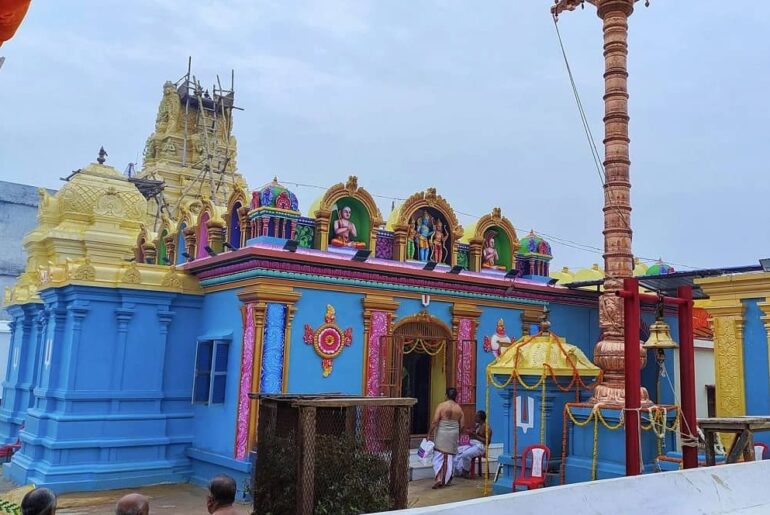Discover Ammaji Mandir Ayodhya, Famous as Divyadesa Temple
My recent pilgrimage to Ayodhya brought me to the enchanting Ammaji Mandir, a place of divine resonance nestled close to the banks of the sacred river Saryu. As I embark on this narrative, I must confess that it is my serious attempt at travel blogging, and I kindly seek your forgiveness for any inadvertent errors that may arise.
Overview: Ammaji Mandir ( Temple )
My sojourn in Ayodhya found its anchor in Ammaji Mandir, also known as Divyadesa Mandir. This splendid temple is dedicated to Lord Sri Rama and resembles the renowned Divyadesams found in Tamil Nadu. From the temple’s architecture to its Archamoorthys (main deities) and mode of worship, everything resonates with the Bhagavad Ramanuja Sampradaya Srivaishnava tradition.
History of Ammaji Temple
Allow me to provide a brief historical backdrop, as gleaned from a temple pamphlet. Ammaji Mandir, a temple steeped in spirituality, has stood on this hallowed ground for 97 years. It owes its existence to the unwavering dedication of a noble soul named Yogi Sri Parthasarathy Ayyangar. The temple’s location is particularly significant, as it stands on the very site where a temple for Sri Ranganatha once graced the landscape.
Suggested Read: Ghats in Ayodhya: Top 5 most famous Ghats

The temple’s primary shrine is dedicated to Lord Sri Rama, accompanied by His divine consort Sita Piratti and His loyal brother Lakshmana. Additionally, the temple houses separate sanctums for deities like Sri Ranganatha, Hanuman, and revered Azhvar Acharyas, represented by Sri Satagopa, Sri Ramanuja, and Sri Manavala Mamunigal. The temple’s worship follows the ancient Pancharathra Agama tradition.
The Visionary Yogi Sri Parthasarathy Ayyangar
Yogi Sri Parthasarathy Ayyangar, the visionary founder of this temple. He was a luminary with profound knowledge of Hindu religious scriptures, theology, and languages like Sanskrit, Tamil, Telugu, and Kannada. He was instrumental in publishing various Hindu religious texts and represented India at the World Congress of Religions in Chicago in 1893. His thesis, “The Science of Religion,” garnered widespread acclaim. Notably, he played a pivotal role in introducing Swami Vivekananda to the world.
Yogi Sri Parthasarathy created the Sri Sarasvathi Bhandar trust, donating his entire wealth to maintain the Ram Temple in Ayodhya. To this day, the temple thrives on the income generated from the properties left behind by the Yogi.
Suggested Read: Saryu Aarti at Ram Ki Pardi Ghat: Time and Booking

The Birth of a Temple
The temple’s origins are steeped in an intriguing tale. One night, Yogi Smt. Singaramma, the wife of Yogi Sri Parathasarathy, had a dream in which she saw the Uthsava Vigrahas (festival deities) of Lord Sri Rama and Seetha Piratti buried in a dilapidated temple in the village of Thiruppullani (Dharbasayanam) in Tamil Nadu’s Ramanathapuram District.
Ammaji Mandir Today
Today, the shrine is affectionately known as Ammaji Mandir, signifying the significant role played by Yogi Sri Parthasarathy’s wife in its development. A stone inscription within the temple also proclaims it as Setu Rama Mandir, reaffirming its origins.
The temple is currently managed by Sriman Srinivasa Ramanujachariar, a retired individual who dedicates his time and energy to its upkeep. His selfless service and hospitality make him a welcoming presence for visitors. The temple provides dormitory-style accommodations, complete with modern amenities such as running water, toilets, and bathrooms. Delicious South Indian food is available as Bhagavath Prasadam upon request.
Exploring Ayodhya’s Spiritual Tapestry
While in Ayodhya, Sriman Srinivasa Ramanujachariar served as our guide, introducing us to some of the town’s notable sites. We visited Makhota, the site where King Dasaratha performed the Puthrakaameshti Yagya, and Guptar Ghat, where Lord Rama entered the River Saryu to ascend to their divine abode, Sri Vaikuntam.
Nandigram
Nandigram, mentioned in the epic Srimad Ramayana as the place where Bharatha patiently awaited Rama, Sita, and Lakshmana’s return, charmed us with its shrine portraying Bharath and Hanuman embracing each other.
A Spirited Ayodhya
Ayodhya is a city that reverberates with the eternal bhajan “SIYARAM” 24 hours a day, 365 days a year, enveloping all in its divine embrace. The city has countless temples, mutts, and the spirit of seva (service) runs deep. No visitor need skip a meal; the SIYARAM bhajan leads them to bounteous Prasadam offerings. Ayodhya is a haven for spiritual seekers and a testament to unwavering devotion.
Conclusion
My journey to Ayodhya and the enlightening experience at Ammaji Mandir left an indelible mark on my soul. This sacred city, steeped in history and spirituality, offers a unique blend of devotion and tranquility. If your travels lead you to Ayodhya. You do include a visit to Ammaji Mandir, and immerse yourself in its timeless grace.
Address and Contact Information for Ammaji Mandir:
Dharbasayana Sethuramar temple AMMAJI MANDIR, 5/3/59, near Nirmochan Chowk Rasta, Kolaghat Road, AYODHYA – 224123 Telephone: +5278 33087
As I conclude this travelogue, I invite you to explore the myriad facets of Ayodhya. It is a city where every door opens to the divine, and every heart beats to the rhythm of SIYARAM.




Comments are closed.